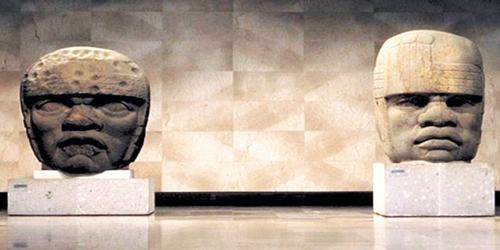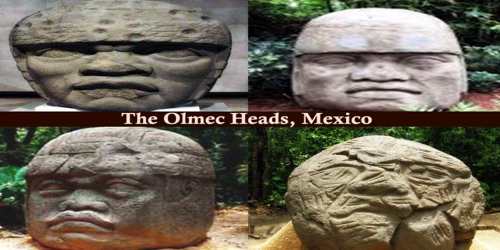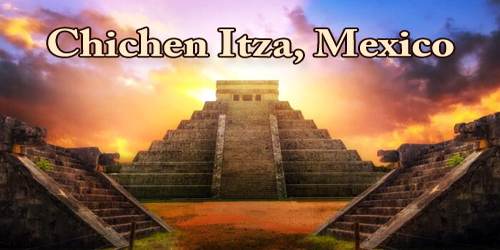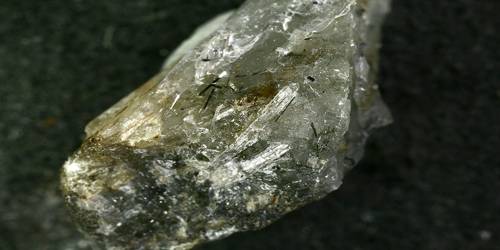The ‘Olmec Colossal Heads’ are stone representations of human heads sculpted from large basalt boulders. These heads are aptly named of the 17 uncovered in the region, the average weight is around 8 tons, standing three meters tall and four and a half meters circumference. Perhaps more than any other aspect of the ‘Olmec heads’, their size is cause for a great deal of analysis and speculation. Each of the Olmec heads is carved with a unique headdress. This led some people to believe that they were carved to represent the powerful Olmec rulers. Others claim that the heads’ faces resemble that of an African male, suggesting that this might be evidence of an advanced African civilization visiting the Americas in prehistoric times.
Olmec, the first elaborate pre-Columbian civilization of Mesoamerica (c. 1200-400 BCE) and one that is thought to have set many of the fundamental patterns evinced by later American Indian cultures of Mexico and Central America, notably the Maya and the Aztec. Evidence has also been found for Olmec hieroglyphs around 650 B.C., as well as scripts on roller stamps and stone artifacts. The fine Olmec artwork survived in several ways, including figurines, sculptures, and of course, the colossal heads. The Nahuatl (Aztec) name for these people, Olmecatl, or Olmec in the modern corruption, means “rubber people” or “people of the rubber country.” That term was chosen because the Olmecs extracted latex from Panama rubber trees (Castilla elastica) growing in the region and mixed it with the juice of a local vine (Ipomoea alba, moonflower) to create rubber.
The discovery of the first colossal head at ‘Tres Zapotes’ in 1862 by José María Melgar y Serrano was never well documented nor reported outside of Mexico. The excavation of the same colossal head by Matthew Stirling in 1938 spurred the first archaeological investigations of Olmec culture. Seventeen confirmed examples are known from four sites within the Olmec heartland on the Gulf Coast of Mexico. Most colossal heads were sculpted from spherical boulders but two from San Lorenzo Tenochtitlán were re-carved from massive stone thrones. An additional monument, at ‘Takalik Abaj’ in Guatemala, is a throne that may have been carved from a colossal head. This is the only known example from outside the Olmec heartland.
The Olmecs Heads are especially identified with 17 huge stone heads ranging in height from 1.47 to 3.4 meters (4.82 to 11.15 feet) with flat faces and full lips, wearing helmetlike headgear. Dating the monuments remains difficult because of the movement of many from their original contexts prior to archaeological investigation. Most have been dated to the Early Preclassic period (1500-1000 BC) with some to the Middle Preclassic (1000-400 BC) period. The smallest weighs 6 tons, while the largest is variously estimated to weigh 40 to 50 tons, although it was abandoned and left uncompleted close to the source of its stone.
While the Olmecs seem to have been well-established tradesmen with routes, the civilization vanished around 300 B.C., although its influence is obvious in the Mayan and Aztec civilizations that followed. The Olmecs lived in hot, humid lowlands along the coast of the Gulf of Mexico in what is now southern Veracruz and Tabasco states in southern Mexico. The first evidence of their remarkable art style appears about 1200 BCE in San Lorenzo, their oldest known building site. This site is remarkable for its many stone monuments, including some of the colossal carved heads mentioned above.
In the late 20th century a stone slab engraved with symbols that appear to have been the Olmec writing system (sometimes called epi-Olmec, or Isthmian) was discovered in the village of Cascajal, near San Lorenzo. The Cascajal stone dates to approximately 900 BCE and maybe the oldest example of writing from the Americas. Other objects containing glyphs include the Tuxtla Statuette, the Chiapa de Corzo shard, the O’Boyle mask, and the La Mojarra stela (discovered 1986). The last object, which displays 465 glyphs, greatly facilitated the interpretation of the epi-Olmec language, though many questions remain.
All seventeen of the confirmed heads in the Olmec heartland were sculpted from basalt mined in the Sierra de los Tuxtlas mountains of Veracruz. Most were formed from coarse-grained dark grey basalt known as Cerro Cintepec basalt after a volcano in the range. Investigators have proposed that large Cerro Cintepec basalt boulders found on the southeastern slopes of the mountains are the source of the stone for the monuments. These boulders are found in an area affected by large lahars (volcanic mudslides) that carried substantial blocks of stone down the mountain slopes, which suggests that the Olmecs did not need to quarry the raw material for sculpting the heads. Roughly spherical boulders were carefully selected to mimic the shape of a human head.
Additionally, the Olmecs heads are not an entirely unique phenomenon. The heads of Easter Island, Mt. Nemrut, and the underwater heads of Egypt all bear resemblance to the Olmecs heads, despite all of these being scattered around the world.

All of the 17 confirmed colossal heads remain in Mexico. Two heads from San Lorenzo are on permanent display at the Museo Nacional de Antropología in Mexico City. Seven of the San Lorenzo heads are on display in the Museo de Antropología de Xalapa. Five of them are in Sala 1, one is in Sala 2, and one is in Patio 1. The remaining San Lorenzo head is in the Museo Comunitario de San Lorenzo Tenochtitlán near Texistepec. All four heads from La Venta are now in Villahermosa, the state capital of Tabasco. Three are in the Parque-Museo La Venta and one is in the Museo del Estado de Tabasco. Two heads are on display in the plaza of Santiago Tuxtla; one from Tres Zapotes and the La Cobata Head. The other Tres Zapotes head is in the Museo Comunitario de Tres Zapotes.
Information Sources:
















